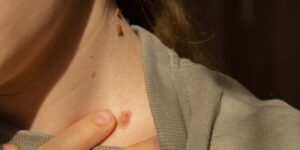 As a PA practicing in dermatology, I often get asked by my patients what to look for when they are checking their own skin for potential skin cancers or odd-looking moles. We discuss that skin cancers do not go away on their own. They stay and continue to grow or change. It is reasonable to come into the clinic about 6-8 weeks after a new lesion has not resolved or gone away. Do you have a new or changing skin lesion? I teach my patients to look for lesions changing in color, shape, and/or size or ones that are bleeding on their own (meaning they are not bleeding due to being scratched or picked at). There are three common types of skin cancers (basal cell carcinoma, squamous cell carcinoma, and melanoma) that we routinely find in dermatology. All of these can be caught early if you are being proactive about looking your skin over, protecting it from the sun regularly, and getting checked preventatively or when needed.
As a PA practicing in dermatology, I often get asked by my patients what to look for when they are checking their own skin for potential skin cancers or odd-looking moles. We discuss that skin cancers do not go away on their own. They stay and continue to grow or change. It is reasonable to come into the clinic about 6-8 weeks after a new lesion has not resolved or gone away. Do you have a new or changing skin lesion? I teach my patients to look for lesions changing in color, shape, and/or size or ones that are bleeding on their own (meaning they are not bleeding due to being scratched or picked at). There are three common types of skin cancers (basal cell carcinoma, squamous cell carcinoma, and melanoma) that we routinely find in dermatology. All of these can be caught early if you are being proactive about looking your skin over, protecting it from the sun regularly, and getting checked preventatively or when needed.
The Sun: The Common Culprit
Sun exposure is involved in all three of these common skin cancer types, so protecting your skin is very important.
How Can I Protect My Skin From the Sun?
I always tell my patients that sun avoidance and protection are both important.
- Avoid the sun during peak times of 10:00 a.m. – 2:00 p.m.
- Choose to sit in the shade.
- Wear a hat.
- Wear a sun shirt with SPF 50.
What Sunscreens Should I Use to Protect My Skin if I Cannot Avoid the Sun or Wear Sun-Protective Clothing?
- Apply sunscreen that is at least an SPF 30, and then reapply every two hours. I often hear from patients, “I wore sunscreen, but I still got burnt,” or “Sunscreen doesn’t work for my skin.” If this happens, that means you’re not using it correctly. Even if you buy the highest SPF sunscreen but only put it on once for the entire day, your skin will not be protected. Reapplication is key as well as how much you are using to cover your body. It’s also a good idea to set a timer for two hours to remind yourself to reapply – two hours goes by fast!
- I do not recommend spray sunscreens unless they are being used on the scalp, and there is hair in the way of using a lotion sunscreen. Otherwise, much of what you’re spraying goes in the air and not on the skin.
- The best ingredients to look for in your lotion sunscreen are zinc oxide and/or titanium dioxide. These would be found in the active ingredients listed on the back the bottle. They cover the most rays of the sun spectrum and give you the best defense against the sun.
I Like to be Proactive About My Health – How Often Should I Come in to be Seen by a Dermatology Provider?
According to the Skin Cancer Foundation, you should see a dermatology provider once a year. However, this can vary, depending on your personal or family history of skin cancer and what is going on with your skin at any given time. If you’re not currently seeing a provider, I recommend scheduling a full body skin exam with your Dermatology PA or other Dermatology provider. During this kind of appointment, we thoroughly examine your skin for lesions that you may not have suspected as a problem. Don’t be surprised if one you thought was worrisome ends up being normal, or one you did not suspect is worrisome to us. We use special tools to look at your skin close up. The most commonly used tool is a dermascope. We hold this above or put it on your skin to see the structures and patterns of lesions that we need to evaluate further than just with our eyes. We make decisions about your lesions based on what we see, and how they might be changing over time. It’s important to talk with your Dermatology provider about your skin and any questions or concerns you may have so they can be properly addressed. For more information on how to protect your skin, visit the Skin Cancer Foundation’s website.

Laura Jarvis, PA-C, MCMS, DFAAPA
Laura Jarvis is a Board Certified PA practicing in dermatology.
